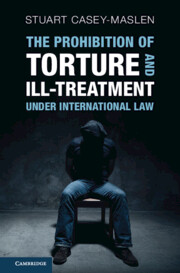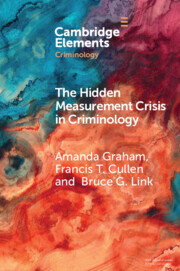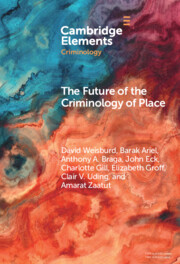Refine search
Actions for selected content:
144 results
“Doing the Real Work”: Latina Women, Resistance, and State Surveillance in a Border County
-
- Journal:
- Journal of Race, Ethnicity and Politics , First View
- Published online by Cambridge University Press:
- 07 October 2025, pp. 1-23
-
- Article
-
- You have access
- Open access
- HTML
- Export citation
The Voracious Frontier: Policing, War, and Mercantilism in Dutch South Africa, 1652–1830
-
- Journal:
- The Journal of African History / Volume 66 / 2025
- Published online by Cambridge University Press:
- 20 August 2025, e8
-
- Article
-
- You have access
- Open access
- HTML
- Export citation
21 - Policing Press Freedom
- from Part V - Identifying Performers of the Press Function
-
-
- Book:
- The Future of Press Freedom
- Published online:
- 25 July 2025
- Print publication:
- 24 July 2025, pp 346-370
-
- Chapter
-
- You have access
- Open access
- HTML
- Export citation
Police Officers’ Evaluation of the Impacts of COVID-19 on Policing, Police Leadership and Police Officer Quality of Life in Trinidad and Tobago
-
- Journal:
- International Annals of Criminology , First View
- Published online by Cambridge University Press:
- 07 July 2025, pp. 1-19
-
- Article
- Export citation
Reconsidering the Passage of the 1925 Peace Preservation Law at its Centennial: 100周年に当たっての治安維持法成⽴の再考
-
- Journal:
- Asia-Pacific Journal / Volume 23 / 2025
- Published online by Cambridge University Press:
- 17 June 2025, e6
-
- Article
-
- You have access
- Open access
- HTML
- Export citation
Tracking (In)Justice: Documenting Fatal Encounters with Police in Canada
-
- Journal:
- Canadian Journal of Law & Society / La Revue Canadienne Droit et Société / Volume 40 / Issue 1 / April 2025
- Published online by Cambridge University Press:
- 16 June 2025, pp. 23-47
-
- Article
-
- You have access
- Open access
- HTML
- Export citation
Policing for Sustainable Development Goals: Lessons from the Nigerian Police Intervention in the COVID-19 Pandemic
-
- Journal:
- International Annals of Criminology , First View
- Published online by Cambridge University Press:
- 16 May 2025, pp. 1-23
-
- Article
- Export citation
7 - Civil Society Mobilization against Equal Citizenship in Latin America
- from Part II - Civil Society, Social Media, and Political Messaging
-
-
- Book:
- Global Challenges to Democracy
- Published online:
- 01 May 2025
- Print publication:
- 15 May 2025, pp 143-158
-
- Chapter
- Export citation
1 - Equality in the Streets
- from Part I - Policing
-
- Book:
- Rehabilitating Criminal Justice
- Published online:
- 17 April 2025
- Print publication:
- 24 April 2025, pp 3-22
-
- Chapter
- Export citation

The Prohibition of Torture and Ill-Treatment under International Law
-
- Published online:
- 17 April 2025
- Print publication:
- 24 April 2025
Social segregation, inter-group contact, and discriminatory policing
-
- Journal:
- Political Science Research and Methods , First View
- Published online by Cambridge University Press:
- 03 April 2025, pp. 1-18
-
- Article
-
- You have access
- Open access
- HTML
- Export citation
Academic Copaganda – CORRIGENDUM
-
- Journal:
- Law & Society Review / Volume 59 / Issue 2 / June 2025
- Published online by Cambridge University Press:
- 28 March 2025, p. 461
- Print publication:
- June 2025
-
- Article
-
- You have access
- Open access
- HTML
- Export citation

The Hidden Measurement Crisis in Criminology
- Procedural Justice as a Case Study
-
- Published online:
- 03 March 2025
- Print publication:
- 27 March 2025
-
- Element
- Export citation
Intimate image abuse offences: stakeholder perspectives of the effectiveness of the new offences in Hong Kong
-
- Journal:
- Legal Studies / Volume 45 / Issue 2 / June 2025
- Published online by Cambridge University Press:
- 24 February 2025, pp. 192-211
- Print publication:
- June 2025
-
- Article
-
- You have access
- Open access
- HTML
- Export citation
Police interrogation and fraudulent epistemic environments
-
- Journal:
- Journal of Public Policy / Volume 45 / Issue 2 / June 2025
- Published online by Cambridge University Press:
- 24 February 2025, pp. 201-223
-
- Article
-
- You have access
- Open access
- HTML
- Export citation
Academic Copaganda
-
- Journal:
- Law & Society Review / Volume 59 / Issue 2 / June 2025
- Published online by Cambridge University Press:
- 03 February 2025, pp. 298-323
- Print publication:
- June 2025
-
- Article
-
- You have access
- Open access
- HTML
- Export citation
Vision and method in global historical sociology
-
- Journal:
- Social Science History / Volume 49 / Issue 1 / Spring 2025
- Published online by Cambridge University Press:
- 23 January 2025, pp. 203-228
- Print publication:
- Spring 2025
-
- Article
-
- You have access
- Open access
- HTML
- Export citation
Breakbulk Pasts and Containerized Futures: Submergent Histories on a Saltwater Frontier
-
- Journal:
- Comparative Studies in Society and History / Volume 67 / Issue 2 / April 2025
- Published online by Cambridge University Press:
- 23 January 2025, pp. 404-428
-
- Article
-
- You have access
- Open access
- HTML
- Export citation

The Future of the Criminology of Place
- New Directions for Research and Practice
-
- Published online:
- 13 January 2025
- Print publication:
- 06 February 2025
-
- Element
- Export citation
Public space at stake: competing forms of territorialisation and the construction of a democratic public space in the first years of the Italian Republic
-
- Journal:
- Modern Italy , First View
- Published online by Cambridge University Press:
- 27 December 2024, pp. 1-13
-
- Article
-
- You have access
- Open access
- HTML
- Export citation
